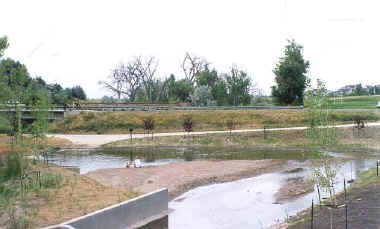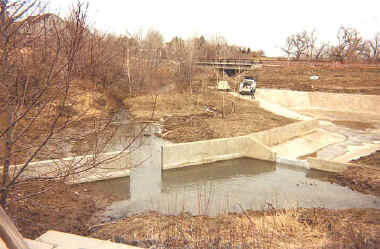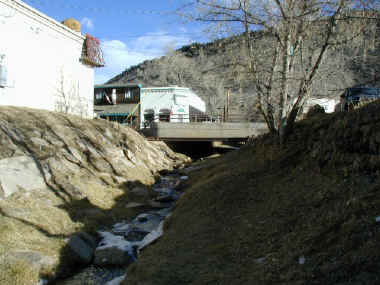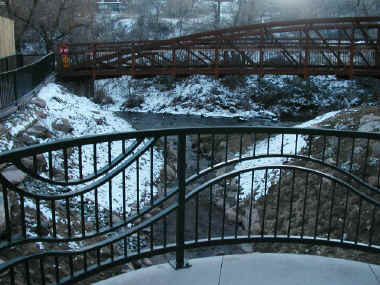MAINTENANCE PROGRAM ACTIVITIES
By Mark R. Hunter, P.E., Manager, Maintenance Program
The Urban Drainage and Flood Control District (District) Maintenance Program
committed a total of $5.8 million in 2004 to maintaining drainageways in the
Denver metropolitan area. Most of these drainageways have been improved sometime
in the past as part of a subdivision development or a capital improvement
project. The bulk of the drainageways we maintain are open channels with
grass-lined banks, riprap erosion protection, and rock or concrete drop
structures (grade control structures).
Our maintenance work covers the spectrum of drainageway work. It includes
debris pick-up and mowing, localized repair to damaged and eroded channels or
detention facilities, and consultant-designed rehabilitation to long reaches of
deteriorated drainageways.
|
Adams
County
|
20.9 miles
|
|
Arapahoe
County
|
39.3 miles
|
|
Boulder
County
|
17.6 miles
|
|
Broomfield
County
|
0.2 miles
|
|
Denver
County
|
44.7 miles
|
|
Douglas
County
|
7.3 miles
|
|
Jefferson
County
|
30.3 miles
|
|
TOTAL
|
160.2 miles
|
Mowing and Debris Pick-up
For the year 2004 we awarded eight contracts for mowing and debris pickups under
our routine maintenance program. Seven of those contracts were awarded as
renewals of the prior year contract. The value of each contract was adjusted to
match the movement in the regional Consumer Price Index over the prior year. The
other contract was awarded through a competitive bid process.
The mowing and debris pick-up work was done on 261 different sections of
urban drainageways within the District's boundaries. The contractual value of
the work was $702,144. The table below summarizes the miles of drainageways
within each county in the District on which we performed regularly scheduled
mowing and/or debris pickup maintenance
|
STATUS OF MAJOR MAINTENANCE PROJECTS |
|
Project
|
Jurisdiction
|
Cost
|
Status
|
|
ADAMS
COUNTY
|
|
Big
Dry Creek – 122nd Ave and Federal
Repair vertical bank and
protect road.
|
Westminster
|
Design
|
$36,560
|
100%
|
|
Const.
|
107,191
|
100%
|
|
Grange
Hall Creek – 108th to Colorado
Remove substantial sediment
buildup.
|
Thornton
|
Design
|
4,280
|
100%
|
|
Const.
|
55,590
|
50%
|
|
Grange
Hall Creek – Grant St. to I-25
Build small drops and repair
channel.
|
Northglenn
|
Design
|
41,766
|
70%
|
|
Const.
|
Next
year
|
0%
|
|
ARAPAHOE
COUNTY
|
|
Big
Dry Creek – Progress Pk. to Lehow
Coordinate channel repair
& trail work.
|
Englewood
|
Design
|
local
gov
|
100%
|
|
Const.
|
78,549
|
100%
|
|
Greenwood
Gulch – U/S Highline Canal
Add sheet pile to drops
built in 1999.
|
Greenwood
Village
|
Design
|
In-house
|
100%
|
|
Const.
|
46,000
|
100%
|
|
Little
Dry Creek – E. of Colorado Blvd
Build drop structures &
repair channel.
|
Centennial
|
Design
|
54,963
|
50%
|
|
Const.
|
Next
year
|
0%
|
|
Westerly
Creek – SE of Miss.& Moline
Rebuild drop in concrete
channel.
|
Aurora
|
Design
|
In-house
|
100%
|
|
Const.
|
75,000
|
100%
|
|
Willow
Creek – South of Dry Ck. Road
Annual cleaning of sediment
trap.
|
Centennial
|
Design
|
In-house
|
100%
|
|
Const.
|
26,183
|
100%
|
|
BOULDER
COUNTY
|
|
Boulder
Crk – West of 9th St, E. Fine Pk
Rebuild river rock drops,
rep.erosion.
|
Boulder
|
Design
|
In-house
|
100%
|
|
Const.
|
100,000
|
20%
|
|
Dry
Creek #2 – N.E. of 55th St. & Arap.
Replace 3 broad drop
structures.
|
Boulder
|
Design
|
43,875
|
85%
|
|
Const
|
Next
year
|
0%
|
|
Rock
Creek – Farm west of Hwy. #287
Channel, bank repair and
trails, partic.
|
Boulder
County
|
Design
|
70,516
|
100%
|
|
Const
|
300,000
|
0%
|
|
BROOMFIELD
COUNTY
|
|
City
Park D'way – Emerald to Midway
Channel and bank repair.
|
Broomfield
|
Design
|
44,678
|
100%
|
|
Const
|
315,000
|
0%
|
|
DENVER
COUNTY
|
|
Cherry
Creek – South Platte confluence
Bank repair and access,
participation.
|
Denver
|
Design
|
Included
|
100%
|
|
Const.
|
75,000
|
100%
|
|
Goldsmith
Gulch – North of Hampden
Channel and bank repair,
participation.
|
Denver
|
Design
|
66,480
|
100%
|
|
Const.
|
800,000
|
100%
|
|
Montbello
Channels – N.E. I-70&Peoria
Ongoing replacement of
concrete chan.
|
Denver
|
Design
|
Previous
|
100%
|
|
Const.
|
150,000
|
10%
|
|
Sanderson
Gulch – At Florida Avenue
Repair banks and add &
repair drops.
|
Denver
|
Design
|
53,066
|
90%
|
|
Const.
|
Next
year
|
0%
|
|
West
Harvard Gulch – Platte R. to R.R.
Drops, channel repair, and
trails, partic.
|
Denver
|
Design
|
79,913
|
75%
|
|
Const.
|
Next
year
|
0%
|
|
West
Harvard Gulch – Zuni to Clay St.
Corridor study, drops,
channel repair.
|
Denver
|
Design
|
73,579
|
90%
|
|
Const.
|
500,000
|
0%
|
|
DOUGLAS
COUNTY
|
|
Happy
Canyon Ck – At Oak Hills Drive
Add a drop to protect
upstream drop.
|
Douglas
County
|
Design
|
32,830
|
90%
|
|
Const.
|
100,000
|
0%
|
|
Longs
Way Trib – W of Dransfeldt Rd.
Repair eroded detention
pond.
|
Parker
|
Design
|
Previous
|
100%
|
|
Const.
|
73,660
|
100%
|
|
Tallman
Gulch – At Siebert Circle
Drops, channel repair, and
trails, partic.
|
Parker
|
Design
|
106,443
|
100%
|
|
Const.
|
375,187
|
100%
|
|
JEFFERSON
COUNTY
|
|
Dutch
Creek – Sheridan Blvd. to Eaton
Drops and repair channel.
|
Jefferson
County
|
Design
|
49,941
|
85%
|
|
Const.
|
Next
year
|
0%
|
|
Lakewood
Gulch – Van Gordon-Welch
Drops and repair channel,
participation.
|
Lakewood
|
Design
|
Included
|
100%
|
|
Const.
|
207,271
|
100%
|
|
Lena
Gulch – From 20th to Youngfield
Drops and repair channel,
participation.
|
Lakewood
|
Design
|
25,000
|
95%
|
|
Const.
|
200,000
|
0%
|
|
McIntyre
Gulch – West of Holland St.
Repair channel banks,
participation.
|
Lakewood
|
Design
|
Stalled
|
90%
|
|
Const.
|
265,000
|
0%
|
|
Mount
Vernon Ck – Confl. w/Bear Ck
Repair narrow urban channel, partic.
|
Morrison
|
Design
|
30,800
|
100%
|
|
Const.
|
120,000
|
100%
|
Restoration Maintenance
In 2004 $3,305,600 of work was performed under our restoration contracts.
Restoration projects typically address isolated drainage problems where the
construction will cost from a few hundred dollars up to $200,000. Ninety-five
individual activities were completed during the year. Several major restoration
projects are shown in the accompanying table titled "STATUS OF MAJOR
MAINTENANCE PROJECTS." A major advantage of the restoration program is the
ability to use it to react quickly to local drainage needs.
Rehabilitation Maintenance
Fifteen rehabilitation projects were at various stages of design or construction
during 2004. Those projects are included in the accompanying table titled
"STATUS OF MAJOR MAINTENANCE PROJECTS." Rehabilitation projects
typically are designed by private consultants and built by private contractors.
They are intended to correct severe problems that have occurred on a previously
improved urban drainageway. By the end of 2004 the District will have spent
about $1,842,300 on rehabilitative design and construction for the year.
Channel Repairs
In last year's Flood Hazard News we described a recent extension of
Federal Boulevard in Westminster that crossed Big Dry Creek at 122nd
Avenue. Erosion was threatening the Federal Boulevard right-of-way at a severe
bend in the creek that included a 25-foot tall near-vertical bank. After
consulting with the permitting agencies the solution was to relocate a short
portion of the creek so the erosive energy of the flow was not directed toward
Federal Boulevard. The project was delayed for three months during the spring
nesting season while bank swallows made use of the steep bank. The completed
project included a backwater wetland at the base of the steep bank. Keeping all
the parties informed and coordinated required close management of the work by
Mike Sarmento, Engineering Inspector.
The Montbello area of Denver is tributary to Montbello Drainage and to
Irondale Gulch. Nearly 10 miles of concrete-lined drainage channels
collect the storm runoff from Montbello. These channels were constructed over
the last 25 years as the subdivisions were built. Their top widths vary from 12
feet up to 35 feet with depths ranging from 4 to 10 feet. For the last seven
years we have been setting aside funds to replace the worst block-long sections.
Our replacement concrete panels include weep holes and steel reinforcement while
most of the original panels did not.
Much of the length of Grange Hall Creek has been improved over the
last 15 years. One of the upper reaches of the creek is within the City of
Northglenn and extends from Grant Street on the east to I-25 on the west. Some
improvements had been constructed in the past, but they are now deteriorating or
being buried by sediment. This corridor has enough width and enough change of
elevation to allow a straight-forward design. However, the drainageway revealed
a major surprise when surveying and utility locations were done. Buried in the
sediment was a storm sewer outlet that drained stormwater from several blocks of
residences. The pipe outlet is well below the proposed grade of the channel so
the design team is now reviewing options for how to deal with the storm sewer.
Multi-purpose Projects
In 2004 we again joined forces with other local governments to fund
multi-purpose projects. The result of this combined funding is projects that
meet a variety of community needs. The City of Morrison wanted to improve the
appearance, drainage function, and urban usefulness of Mount Vernon Creek
at its confluence with Bear Creek. All these goals were met through a
focused design and concentrated effort by Cindy Thrush, Senior Project Engineer,
and Jeff Fisher, Engineering Inspector.
A similar multi-purpose project at the confluence of Cherry Creek and
the South Platte River brought together funds from the Maintenance
Program, the South Platte River Program, The City and County of Denver, and the
Greenway Foundation. The project created an urban park at the edge of the two
streams that are considered to be the birthplace of the city.
Boulder County has a very different problem with Rock Creek which
enjoys a broad open-space corridor on the west side of Highway No. 287. This
section of the creek has seen very little direct impact from humans. The
exception is that in-stream erosion has damaged the natural habitat of the
corridor. The close coordination of multiple interests has been guided by David
Bennetts, Senior Project Engineer. We will participate by funding the drop
structures to limit the down-cutting of the creek while Boulder County will
contribute toward the bank shaping and restoration of the habitat.
Detention Ponds and Sediment Control
In remote areas such as the Canyonlands of Utah or the Grand Canyon of Arizona
erosion and sedimentation are normal occurrences. Even if the resultant changes
are severe they are a natural and expected component of the environment. Urban
settings are far less tolerant of aggradation and sedimentation. A change in
elevation of a few feet can have a dramatic impact of the flow characteristics
and the associated floodplain of an urban stream. In the past year the
maintenance Program carried out significant sediment removals on Harvard
Gulch from University Boulevard to Colorado Boulevard, on Grange Hall
Creek from 108th Avenue to Colorado Boulevard, and at the sediment trap on Willow
Creek south of Dry Creek Road. Additional sediment removals were also done
on 10 to 15 other channels and detention ponds within the District.
Concrete-lined channels can be even more sensitive to aggradation where even a
couple inches of sediment is visible and can support undesirable vegetation.
A detention pond was built in the late 1990s on the Long's Way Tributary
near it's confluence with Cherry Creek in Parker. At the downstream end of this
pond a lowered micro-pool had been installed to trap sediments and provide a
maintainable feature that would improve the quality of the water discharged from
the pond. The five foot elevation drop from the trickle channel into the
micro-pool was made of graded earth. When the pond would detain water the
elevation difference was drowned out by the water and little or no erosion
occurred. However, at lower flow rates erosion was occurring as the water
dropped into the micro-pool. Our solution was to restore the micro-pool by
creating a sculpted concrete drop structure with a concrete cutoff wall to
separate the main detention pond from the micro-pool.
Drop Structures
Drop structures can fail when water flows through, under, or around them due to
an inadequate cutoff wall. We repaired several drops in 2004 that suffered from
poor cutoff walls. Grouted boulder drops were built on Greenwood Gulch
north of Orchard Road in Greenwood Village in 1999. The excavated trench for the
original grout curtain simply did not extend to the depth called for in the
plans. We repaired 4 of these drops a couple years ago and repaired an
additional one in 2004. We were able to clean up the upstream side of the
boulders and then drive sheet pile and grout it in place to bind the whole
structure together.
Westerly Creek is one of several drainageways in Aurora that have been
constructed as trapezoidal concrete channels. Vertical concrete drop structures
were installed where necessary. Some of the drops did not have satisfactory
foundations to support the vertical wall of the structure. The weak foundation
allowed differential movement among the concrete panels which, in turn, allowed
water to flow under and around the structure and pick up soil particles. The
result was that the concrete panels near the drop structure became undermined
and eventually collapsed. Last year we rebuilt one of these drops north of
Mississippi Avenue. This year we reconstructed the structure that is southeast
of Mississippi Avenue and Moline Street. The redesigned drops have also improved
upon the existing underdrain systems which protect the foundations of the drop
structures by controlling the ground water.
Over the last 15 years the City of Boulder has used rounded river boulders to
build attractive drop structures in Boulder Creek. Those drops that were
not grouted have experienced movement of some of the boulders. As the boulders
tumble out of their configuration the drop structure looses its integrity. We
re-used the rounded boulders and locked them in place with a grouted cutoff
wall. We also restored any damaged stream banks in the vicinity of the drops.
Photo Gallery





